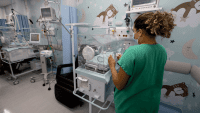These contributions enhance engagement, empowerment, and professional development.
Takeaways:
- Exemplar writing for the Magnet application requires reflection, evidence gathering, and research.
- Clinical nurse participation in exemplar writing can aid engagement and professional growth.
Clinical nurses play a critical role in collecting evidence for and writing and editing exemplars (detailed descriptions of projects and activities that support nursing excellence) for the American Nurses Credentialing Center Magnet® application. Nurse involvement enhances their engagement and empowers them to advance within the profession. (See Personal story: Tiffany Nawabi.)
A personal story: Tiffany Nawabi


I recently embarked on a life-changing journey. As a clinical nurse, I had the opportunity to not only edit but help write my organization’s Magnet® Application exemplars. When I delved into the inspiring work we do under the Magnet model, I envisioned a brighter world for nursing.
When I asked other clinical nurses to explain their projects, they shared heartfelt memories when describing their undertakings, including what sparked the initial ideas. This heart and soul behind exemplars are the bread and butter of organizations that receive Magnet designation.
Being exposed to the exemplars renewed my passion for the nursing profession and re-energized my bedside patient care. Having the opportunity to view the breadth of my organization’s behind-the-scenes work, improvement projects, and quality data through the critical lens of a Magnet writer empowered me. The reflective writing and editing process translated into a renewed sense of pride in my organization and for the profession of nursing. It prompted me to return to school to obtain my master’s in nursing.
Enhancing engagement
The sense of ownership that comes from active participation in the evidence-based Magnet application process helps advance nurses’ knowledge of current best practices and encourages sharing projects and innovations across units and departments. Ultimately, this involvement inspires frontline nurses to advance their education and accelerate their career path, developing future leaders.
Although much has been written about including clinical nurses in an organization’s research, little information exists on how to integrate them, with their holistic patient-centered viewpoint, into the Magnet exemplar writing process. Combining a clinical nurse’s perspective with a bird’s eye view of nursing leadership enhances exemplars and ongoing quality improvement projects. In addition, the reflective writing process helps clinical nurses network, broaden their horizons, build organization-wide interdisciplinary connections, and develop a renewed sense of pride in their profession and organization, all of which aids organization succession planning.
Recommendations
Tailor nurse involvement in Magnet exemplar writing to the unique characteristics of your organization. For example, assign interested clinical nurses to write or collect evidence for specific exemplars they have some familiarity with, such as their unit’s quality improvement projects. Such an assignment encourages nurses to look more closely at the evidence-based Magnet tenets and makes them aware of the organizational structures in place to support them. If you want to encourage nurses to dive into a new subject, ask them to gather data, collect evidence, and write about a project they aren’t familiar with. For example, an inpatient nurse could review an ambulatory clinic’s work.
Some may argue that nurses, already overextended, don’t have the bandwidth for extra work. However, many staff nurses are already interested in advancing their careers, developing professionally, and flexing their muscles with a new skill set. The inspirational world of Magnet provides an excellent place to start.
Let’s start writing
Because Magnet exemplars highlight nursing practice excellence and depict a culture of high-quality, evidence-based, patient-centered care, they demonstrate that an organization empowers nurses to develop professionally and promotes innovation. The exemplars underscore the five components of the Magnet Model: transformational leadership; structural empowerment; exemplary professional practice; and new knowledge, innovations, and improvements—with empirical outcomes embedded throughout.
The two types of exemplars consist of nonempirical outcomes (non-EO), with corresponding evidence, and empirical outcomes (EO), with a graph reflecting outcome data. (See Exemplar writing tips.)
Exemplar writing tips


Follow these tips when writing exemplars for your organization’s Magnet® Application.
- Comply with the Health Insurance Portability and Accountability Act guidelines and remove all patient identifiers and protected health information.
- To ensure you capture multiple perspectives and accurately describe the project, speak to those involved, including unit managers, clinical nurses, case managers, and physicians.
- If citing sources, include a reference section at the end of each exemplar.
- When writing about colleagues, include their credentials and official titles.
- For a nonempirical exemplar (narrative), start by verifying your five sources of evidence and use them to write the exemplar. Explain how each is operationalized within the organization.
- For an empirical-outcome exemplar, verify your data before writing. You’ll need preintervention data, information collected during the intervention, and three postintervention data points that demonstrate improvement. The outcome data (not process data) must be in uniform time increments across the timeline.
- Don’t rush. Writing a little, letting it sit, and then coming back to it can refresh your perspective.
- After you’ve written the exemplar, ask a peer to review it for accuracy.
- Enjoy the process of reflecting on and writing about your organization’s exceptional work and innovations.
- If the project was published or presented at a conference, include those details at the end of the exemplar.
If not, consider publishing or presenting your work.
When writing an exemplar, start by reflecting on the project and gathering any evidence you may have, such as A3s (a problem-solving and process improvement tool, so named for the large A3 paper it’s printed on), literature reviews, policies, presentations, meeting minutes, email correspondence, and data. Then develop a timeline of the project. Include major dates and then fill in details. When writing, be concise and ensure that your topic stays on track. Exemplars don’t need to be polished gems, but they do need to be accurate and reflective chronicles of your work and clinical outcomes.
Moving forward
If you’re interested in embarking on Magnet exemplar writing or editing, approach your organization’s Magnet program director, who has strategic oversight over the Magnet Recognition Program and exemplars. They can help you focus your narrative’s scope, assign exemplars for you to write, and serve as a resource for you throughout the process.
Writing exemplars may seem daunting at first, but what better way to advance your practice than by reflecting on your work and your organization’s commitment to excellence. Writing and editing exemplars can help you prepare to return to school, advance your career, explore a new career path, or strengthen your evidence-based bedside practice.
Tiffany Nawabi and Darlene Frie are clinical nurses at Stanford Health Care in Stanford, California, and they helped with the organization’s 2016 and 2020 Magnet submissions.
Acknowledgements
The authors wish to thank Katie Stephens, DNP, RN, NEA-BC, director of nursing excellence and Magnet programs, and Elizabeth Borgueta, MSN, RN, CCRN, SCRN, CWCN, program manager–nursing excellence and Magnet at Stanford Health Care, for their support of this manuscript.
References
American Nurses Credentialing Center. 2019 Magnet® Application Manual. Silver Spring, MD: American Nurses Credentialing Center; 2017.
Beckman BP. The power of Magnet: Changing nurses, changing nursing. J Nurs Adm. 2019;49(9):400-1. doi:10.1097/NNA.0000000000000775
Hatfield LA, Kutney-Lee A, Hallowell SG, et al. Fostering clinical nurse research in a hospital context. J Nurs Adm. 2016;46(5):245-9. doi:10.1097/NNA.0000000000000338
Kanaskie ML, Reynolds KA. Sustaining the development of clinical nurses within a Magnet organization. Nurs Clin North Am. 2020;55(1):
109-20. doi:10.1016/j.cnur.2019.10.008
Moreno JV, Girard AS, Foad W. Realigning shared governance with Magnet® and the organization’s operating system to achieve clinical excellence. J Nurs Adm. 2018;48:160-7. doi:10.1097/NNA.0000000000000591
Powers J. Increasing capacity for nursing research in Magnet-designated organizations to promote nursing research. Appl Nurs Res. 2020;55:151286. doi:10.1016/j.apnr.2020.151286
Ta’an WF, Alhurani J, Alhalal E, Al-Dwaikat TN, Al-Faouri I. Nursing empowerment: How job performance is affected by a structurally empowered work environment. J Nurs Adm. 2020;50(12):635-41. doi:10.1097/NNA.0000000000000951
Key words: Magnet®, Exemplar writing, Professional development, Clinical nurse empowerment


















